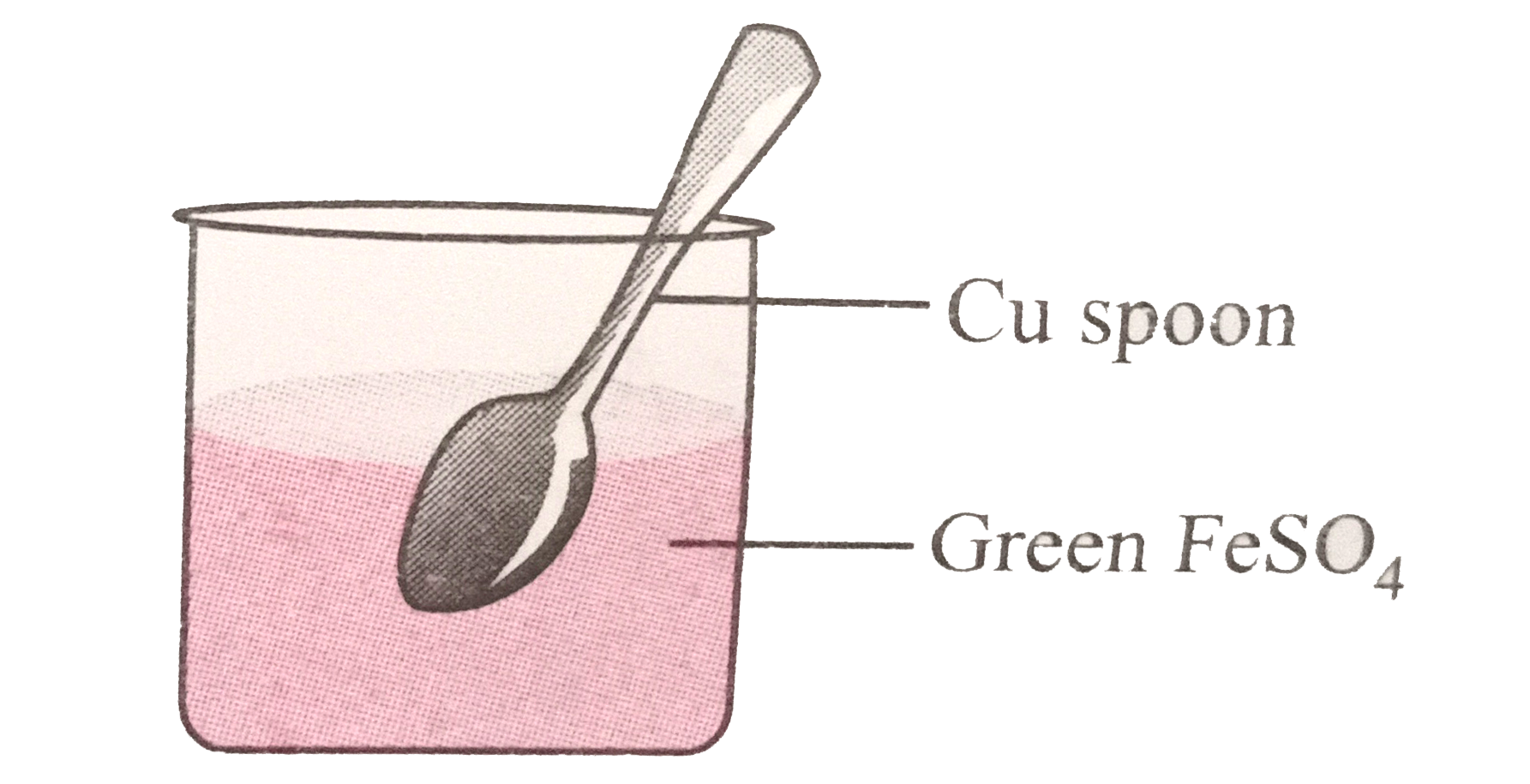A copper rod is placen in AgNO3 solution and FeSO4 solution. What changes do you obseve ? What type of reactions takes place ? Justify your observation.
Step-by-Step Solution
1. Observation with AgNO3 Solution:
- When a copper rod is placed in silver nitrate (AgNO3) solution, a chemical reaction occurs. Copper (Cu) is more reactive than silver (Ag) according to the reactivity series. Therefore, copper displaces silver from the silver nitrate solution.
- The reaction can be represented as:
Cu+2AgNO3→Cu(NO3)2+2Ag
- As a result of this reaction, the colorless silver nitrate solution turns blue due to the formation of copper(II) nitrate, which is blue in color. Additionally, solid silver (Ag) is deposited.
2. Observation with FeSO4 Solution:
- When the same copper rod is placed in iron(II) sulfate (FeSO4) solution, no reaction occurs. This is because copper is less reactive than iron (Fe) in the reactivity series. Therefore, copper cannot displace iron from the iron sulfate solution.
- The reaction can be summarized as:
No Reaction
- The color of the iron(II) sulfate solution remains blue-green, as there is no change in the solution.
3. Type of Reactions:
- The reaction with AgNO3 is a displacement reaction because a more reactive metal (Cu) displaces a less reactive metal (Ag) from its compound.
- The reaction with FeSO4 is characterized by no reaction since the less reactive metal (Cu) cannot displace the more reactive metal (Fe).
4. Justification of Observations:
- The change in color of the AgNO3 solution from colorless to blue indicates the formation of copper(II) nitrate, confirming that a displacement reaction has taken place.
- The lack of color change in the FeSO4 solution indicates that no reaction occurred, as copper is unable to displace iron.
- When a copper rod is placed in silver nitrate (AgNO3) solution, a chemical reaction occurs. Copper (Cu) is more reactive than silver (Ag) according to the reactivity series. Therefore, copper displaces silver from the silver nitrate solution.
- The reaction can be represented as:
Cu+2AgNO3→Cu(NO3)2+2Ag
- As a result of this reaction, the colorless silver nitrate solution turns blue due to the formation of copper(II) nitrate, which is blue in color. Additionally, solid silver (Ag) is deposited.
- When the same copper rod is placed in iron(II) sulfate (FeSO4) solution, no reaction occurs. This is because copper is less reactive than iron (Fe) in the reactivity series. Therefore, copper cannot displace iron from the iron sulfate solution.
- The reaction can be summarized as:
No Reaction
- The color of the iron(II) sulfate solution remains blue-green, as there is no change in the solution.
- The reaction with AgNO3 is a displacement reaction because a more reactive metal (Cu) displaces a less reactive metal (Ag) from its compound.
- The reaction with FeSO4 is characterized by no reaction since the less reactive metal (Cu) cannot displace the more reactive metal (Fe).
- The change in color of the AgNO3 solution from colorless to blue indicates the formation of copper(II) nitrate, confirming that a displacement reaction has taken place.
- The lack of color change in the FeSO4 solution indicates that no reaction occurred, as copper is unable to displace iron.
Topper's Solved these Questions
- BOOK - PEARSON IIT JEE FOUNDATIONCHAPTER - NATURE OF MATTER EXERCISE - LEVEL 310videos
NATURE OF MATTER
- BOOK - PEARSON IIT JEE FOUNDATIONCHAPTER - NATURE OF MATTER EXERCISE - LEVEL 145videos
NATURE OF MATTER
- BOOK - PEARSON IIT JEE FOUNDATIONCHAPTER - METALS AND NON-METALSEXERCISE - Level-3 Concept Application10videos
METALS AND NON-METALS
- BOOK - PEARSON IIT JEE FOUNDATIONCHAPTER - Organic ChemistryEXERCISE - Level 39videos
Organic Chemistry
Similar Questions
Knowledge Check
- Question 1 - Select One
When a copper wire is placed I a solution of AgNO3, the solution acquires blue colour. This due to the formation of .
ASoluble complex of copper with AgNO3BCu+ionsCCu2+ ionsDcu− ion by the reduction of Cu - Question 2 - Select One
When a copper wire is placed I a solution of AgNO3, the solution acquires blue colour. This due to the formation of .
ACu2+ ionsBCu+ ionsCSoluble complexof copper with AgNO3DCu− ion by the reduction of Cu - Question 3 - Select One
When Cu reacts with AgNO3 solution, the reaction takes place is
AOxidation of CuBReduction of CuCOxidation of AgDReduction of NO−3
CaOCl2 in aqueous solution changes to CI2 . What is the type of this change ?
View SolutionWhat is the solution in which photographic film is washed? What reaction takes place?
View SolutionWhat is the solution in which photographic film is washed? What reaction takes place?
View SolutionWhat type of changes takes place during crystallisation of a substance?
View SolutionIf a spoon of copper metal is placed in a solution of FeSO4, what will be the correct observation ?
 View Solution
View Solution

